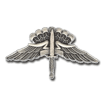
Description
A silver colored metal badge, 1-31/32 inches in width, consisting of a dagger and arched tab superimposed over wings and a deployed 7-cell ram-air square parachute.
Symbolism
The dagger, a Fairbairn-Sykes knife used by the Rangers and Office of Strategic Services in World War II, symbolizes infiltration techniques used by Special Operations Forces. The arched tab symbolizes the tabs worn by Special Operations units. The wing suggests flight and airborne capabilities. The parachute is a depiction of an MT1-X, the first square parachute to be adopted by all military services as the standard military free fall canopy.
Award Eligibility
An individual must meet one of the following criteria: Have satisfactorily completed a prescribed program of instruction in military free fall approved by the U.S. Army John F. Kennedy Special Warfare Center and School (USAJFKSWC&S) or have executed a military free fall combat jump.
A bronze service star is authorized to be worn on all degrees of the badge to denote a soldier’s participation in a combat parachute jump. A soldier’s combat parachute jump credit is tied directly to the assault landing credit decision for the unit to which the soldier is assigned or attached at the time of the assault landing. Should a unit be denied air assault credit, no air assault credit for purpose of this badge will accrue to the individual soldiers of that unit. Each soldier must physically exit the aircraft to receive combat parachute jump credit and entitlement to wear the badge with bronze service star.
Date Approved
The Military Free Fall Parachutist Badge designed by Mr. James Phillips of the Special Forces Association was approved by General Dennis J. Reimer, former Chief of Staff of the Army on July 7, 1997.